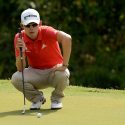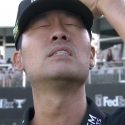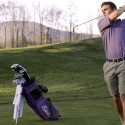 2025 CJ Cup Byron Nelson payout: Purse info, winner’s share
2025 CJ Cup Byron Nelson payout: Purse info, winner’s share
Tour Confidential: Can the PGA Tour do more to support lesser events?
Check in every Sunday night for the unfiltered opinions of our writers and editors as they break down the hottest topics in the sport, and join the conversation by tweeting us @golf_com. This week we discuss the Tour’s lack of star power at certain events, a harsh suspension in Korea, driver testing, Kevin Na’s big victory and more.
1. The Houston Open used to be a popular stop for pros prepping for the following week’s Masters or for those still trying to qualify, but it was one of the handful of events shuffled this offseason. Instead of its normal spring date it will now be played this week at the Golf Club of Houston, but the schedule change hasn’t been kind to the field — not one player in the top 30 in the World Ranking is playing. Tournament director Colby Callaway told GOLF.com: “I’m learning that in the fall, players are interested in chasing the big money internationally and playing overseas. That’s not up to me to figure that out, but up to the Tour to help out because there are tournaments here who are saying, ‘What about us?'” The Tour requires players who make less than 25 starts/season to add a new event to their schedules they haven’t played in the past four seasons, but is that enough? If not, what else can the Tour do to bring star power to lesser events?
Sean Zak, senior editor (@Sean_Zak): The Tour can definitely sequence these events better. There’s a West Coast swing and a Florida swing for a reason. Now there’s a quasi-swing happening in the Midwest. Houston would be best off being slotted before or after any of the three Texas events. Or perhaps the Zurich Classic since NOLA isn’t far away. The biggest deterrent to top-notch pros showing up is being slated in the fall before the big money shows up. That’s the bottom line, and I think the event could have seen that coming.
Luke Kerr-Dineen, instruction editor (@LukeKerrDineen): I wholly agree with Sean. I like when the PGA Tour clusters these events together. It helps players get into a rhythm they can plan for. Will that help bolster the fields of these events? It won’t hurt. But ultimately, unless these events start tossing around more money, players are going to continue overlooking them for the ones that do.
Michael Bamberger, senior writer: I’m afraid this is all under the category of survival of the fittest, and the new, or current, world order. The traditional Tour as many of us grew up on is dead. That Tour was rooted in community. The current Tour is rooted in corporate profit and player payday. Those things kill tradition but it’s the way of the world.
Jonathan Wall, equipment editor (@jonathanrwall): I’m with Michael here. These guys are private contractors and follow the money. Unfortunately, the Houston Open fell on tough times and has suffered mightily with a brutal spot on the schedule. Credit to Astros owner Jim Crane for reviving the event, but there’s little to no chance marquee names are showing up the week prior to a stretch of events in Asia with massive purses. I’d still love to see Houston return to the main rotation at some point, but it won’t be the week prior to Augusta with Valero’s big-money sponsorship.
2. Korean PGA Tour money leader Bio Kim was suspended for three years for flipping off a fan whose camera click went off in his backswing. Kim later won the tournament, but the damage was already done. American golf fans — on social media, anyway — were largely outraged by the punishment. Were you?
Zak: I wasn’t “outraged,” to use our term of choice. That reaction speaks to an all-too common America-knows-best mentality shared here in the States. I was definitely surprised, but I knew absolutely NOTHING about what is OK and not OK in Korean culture. I learned some when reading Michael Bamberger. I think if the punishment was this severe, then my intuition says Kim should have known that was possible. I feel bad for him because he made a mistake but, alas, there are other golf tours for him. They might even welcome him with an invite.
Kerr-Dineen: It was one of the many things I was outraged about on social media last week, but that said, it does seem overly harsh by any standards.
Bamberger: It makes no sense, to us. It makes total sense, to them. You’ll never see another bird on the Korean Tour unless it is flying.
Wall: It’s one of the most ridiculous things I’ve ever seen in the sport — and that’s saying something. I understand the Korean Tour has rules that must be followed, even if I don’t agree with them. Good thing for Bio, golf is a global game. He’ll find another spot to play.
3. Kevin Na won the Shriners in a playoff on Sunday, and the 36-year-old has now racked up three victories in the last 16 months, making him an intriguing candidate for Tiger Woods when he makes his Presidents Cup captain’s picks. But with Rickie, Reed, Finau, Jordan, Phil and even Tiger himself among those vying for picks, is this too little too late for Na?
Zak: No! It’s not too late. You want players in good form. If at the time Tiger is ready to make his picks Na seems like he’s in better form to play in Australia than, say, Rickie Fowler, then Na should be picked. Tiger and Na get along well, too, which should be a little feather in his cap.
Kerr-Dineen: It shouldn’t be hard at all! The bottom of the order for the U.S. team is looking pretty sketchy, filled with Reeds and Spieths who have flattered to deceive for most of the last season. Kevin Na is one of the few players in that class that has actually stepped up. He putted out of his mind last week, and if a guy like that can’t get a serious look, what are we even doing here?
Bamberger: I fear that the Presidents Cup has elements of The Bachelor or something like it. In other words, popularity is a huge factor, consciously or not. Hard to imagine K. Na getting a nod.
Wall: I don’t think it’ll make a difference. My guess is Tiger already has a good idea of who he’s taking to Australia. Don’t believe Na is on the short list.
ADVERTISEMENT
4. Brooks Koepka proved he can win more than just major championships last season, but in his first start of this season he shot 70-71 and missed the cut at the Shriners. In 2019-20, will we see Brooks “regress” back to a player who only shows up at the majors, or do you expect he’ll be a more consistent force at regular Tour stops as well?
Zak: We can’t expect him to continue playing as well as he has in majors, but if what he says is true — that he feels close to 100 percent health-wise for the first time in a long time — I’d expect him to elevate his performance in non-majors. How high? Ten-plus top 10s in 2020. Something like that.
Kerr-Dineen: Something has to give with Brooks, because I can’t believe this whole only-turning-up-for-the-majors thing is sustainable. Maybe he’ll take a step back in majors and fade away generally because of it, a la Martin Kaymer. Is that possible? Of course. But I think it’s more likely we’ll see his regular season form begin to mirror his major form. We’ll see Brooks regress slightly in the majors (simply because his record last season was so absurdly good), but perform at a higher level week in, week out.
Bamberger: Brooks is due for a quiet year. I feel sorry for the 2021 majors.
Wall: Koepka isn’t Tiger. I think he “regresses” this season and doesn’t win a major. Still expect him to contend. No chance he fades into the background.
5. Five players’ drivers (out of the 30 tested) were deemed non-conforming at the Safeway Open, according to a Reuters report. This comes less than a month after the Tour sent a memo regarding mandatory driver testing protocol for the upcoming season. All five drivers reportedly exceeded the CT limit of 257 microseconds. Does the Tour have a potential problem on its hands?
Zak: The Tour definitely has a perception problem. The binary world of legal/illegal has far worse connotation than what is at stake with legal/illegal drivers: largely 5 to 10 yards. It would be wise to inform as many people as possible — us media included — about what is truly at stake. Perhaps the Tour has already done this enough, but the more “illegal” drivers that show up at events, the worse it looks for the competitors and the Tour itself.
Kerr-Dineen: I can’t help but think this whole thing is slightly overblown. A player getting a legal driver, practicing with it a bunch (as Tour players do), wearing out the face ever so slightly and making the clubface microscopically hotter, resulting in the cause of the distance issue plaguing golf. It’s a red herring. I’m not opposed to testing, but if the Tour wants to get serious about reigning in these guys: Grow out the rough, put up more white stakes and take a hard look at the rest of the equipment.
Bamberger: Not a potential problem. A serious problem.
Wall: The Tour and USGA (who’s conducting the driver testing) have a far bigger problem than a few drivers passing the .257 microsecond mark. For the second time this year, we have players outright questioning the testing protocol. What no one is talking about is the fact that the manufacturer and USGA are using different CT machines to test these drivers. When you’re measuring in microseconds, it doesn’t take much (different testing procedure, calibration method) to alter the results. If the USGA and manufacturer are getting different numbers, that’s a problem. A big problem. Who the hell is right? No one knows.
6. Last week California Gov. Gavin Newsom signed into law the Fair Pay to Play Act, which is scheduled to take effect in 2023 and will have ramifications on college golf, given college athletes in the Golden State will be permitted to hire agents and earn money via endorsement deals. Will this bill result in more positives or negatives?
Zak: For us? It’s hard to not like the capitalistic positives in tow. But I’m just worried what it will mean for big-time amateur events. How the USGA responds to this bill (and the similar bill likely to pass in Florida) will determine how its premier amateur events sustain their prominence in the game. If amateurs can make money playing at Stanford and Cal, but then not compete in the U.S. Am or Walker Cup, we are definitely worse off.
Kerr-Dineen: This isn’t going to be as big a deal for college golfers as you might think. College golf isn’t high stakes enough for incoming freshmen to command vast sums of money. And if they could, they’d probably just rather turn pro, where there’s certainly more money to be made. The reason why this bill exists is not for the college golfers of the world. It’s for the superstar college football players who, unlike golfers, don’t have the option of turning pro. They have to wait around for three years to be allowed to get drafted, at which point they’re subject to a salary cap. This is a game changer for them. Sure, the odd college golfer will start receiving nominal sums of money from equipment companies, and the NCAA will adjust to account for it, but the best college golfers aren’t playing because they’re being forced to at the expense of their earning potential. I doubt the entire landscape of college golf will change much, if at all.
Bamberger: More negatives. But it was inevitable, and the right thing to do, and 49 other states will follow suit in the next decade, is the guess from this bureau.
Wall: This was bound to happen. The NCAA is a shady organization and athletes deserve to make money off their name and likeness. That being said, I doubt this has a major effect on college golf.
To receive GOLF’s all-new newsletters, subscribe for free here.
ADVERTISEMENT








